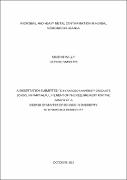| dc.description.abstract | The use of herbal medicines in various countries has been on the increase over the years for primary health care since they are cheap and easily accessible. However, herbal medicines present safety concerns which are continuously undermined by practitioners who use unhygienic methods of preparation. This subjects them to relatively high risks of contamination by pathogenic microbes, organic and inorganic pollutants, mycotoxins, endotoxins, and agrochemical residues.
This research focused on heavy metal and microbial contamination in different herbal medicines sold in Kampala Capital City markets. Five different herbal medicines used for treatment of ulcers, cough, malaria, and diabetes were randomly selected from different markets in Katwe, Nateete and Mengo markets within Kampala Capital City Authority. All the herbal medicines were analysed for microbial contamination and only 14 herbal medicines were tested for heavy metal toxicity. Bacterial isolates were identified basing on morphological, cultural and biochemical tests. Heavy metals were quantitatively determined using atomic absorption spectrophotometry.
The study focused on contamination with most prevalent micro-organisms found in unhygienic and polluted environments of Escherichia coli, Enterobacter aerogenes, Staphylococcus aureus and heavy metals of Nickel, Chromium, lead, and cadmium and their concentrations in ready to use herbal medicines of cough, malaria, ulcer and diabetes.
Approximately 90% of the herbal medicines analysed were found contaminated with pathogenic bacteria, of which Staphylococcus aureus, Escherichia coli, were the most prevalent micro-organisms. Herbal medicines used for the treatment of ulcer and cough were found having the highest contamination by microbes of about 65%, diabetes and malaria with 25% contamination. Heavy metal contamination was about 85% of which lead and Nickel were abundant in most herbal medicines analysed in the ranges of 0.0120 to 2.0808for lead and 0.0120 to 0.9548 for Nickel. Cadmium and Chromium were not detected. About 40% of the ulcer and malaria herbal medicines analysed showed high Nickel concentration to about 60%, while lead contamination predominated to about 75% in most therapies. The concentrations of lead and Nickel were higher than the maximum permissible daily limits in 60% of all herbal medicines analysed. Tests for specific micro-organisms were carried out and samples showed contamination by Escherichia Coli, Staphylococcus, aureus, fungus and moulds but none of the samples were contaminated by Salmonella species. Contamination with toxic heavy metals may be as a result of polluted environment, soils and methods used for preparation. | en_US |

